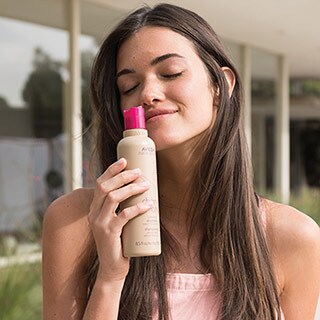Aveda: How did your career begin? Did you always know you were destined to create aromas for a living?
I started out as an apprentice brewer when I was 18. I went and studied things associated with that, like microbiology, biochemistry and some engineering relating to brewing. When I was about 21 or 22, I realized that I would be an unhealthy old man if I stayed in that business. I’d always been into health and well-being so I went and studied natural medicine in Australia: herbal medicine, massage, naturopathy.
One of the subjects [I studied] was aromatherapy. When I was a brewer, I had a very good sense of smell and taste. I’d become fascinated with perfume and things that smell, and I had a very good, discriminatory palate. When I studied aromatherapy, it was a real eye opener. I had no idea about aromatherapy until that class. Here was this model that was good for you and also smelled great. I was immediately drawn to it and fascinated by it and wanted to know more. My then-lecturer had aromatherapy business as well, making lots of lotions, potions and cosmetic products, almost like a mini Aveda. I ended up working with him. I had the manufacturing background and I helped him with parts of his business, like quality control and quality assurance, and I also filled bottles, making cremes and lotions. I was very much on the manufacturing side rather than the treatment side.
Aveda: When did you start transitioning into the actual smelling part of the job?
I’d worked in a number of different companies in Australia doing the same thing, one of which was associated with the Aveda distributor in Australia. That’s where I got to know the brand, back in the early ‘90s. It was more spa and skin care in Australia at the time. Because I kept this obsession with essential oils and where they’re from, I wanted to learn more about perfumery. I was fascinated with the chemistry of it. I started studying with a perfumer based in Thailand, then I ended up wanting to learn more. I sold everything I had, packed a bag and went traveling. I went off chasing all the different essential oils, from taking canoe trips to Laos trying to find benzoin trees, I flew to Bulgaria and hitchhiked while going to the rose and lavender harvest. I did the same in France — I went to Grasse and went from [fragrance] distillery to distillery, knocking on doors and asking questions to get to know as many people as I could. I ended up working at one place in Provence for a summer in their lab, working on essential oils and matching them. Then I ended up in London working for another aromatherapy company, creating and formulating for them. I was there for about seven years. Aveda asked me to come and apply for the position as perfumer in about 2009, and in 2010, I started at Aveda.
At Aveda, we work with essential oils and naturally-derived aroma ingredients. Did you always work with these types of ingredients? What was the Aveda application process like?
I did [use synthetics] in Thailand and London. But because I had specialized in my career as a natural perfumer, my forte is in that space. Because I’d known Aveda from the early ‘90s, it wasn’t a huge learning curve and that’s why I got the job. I received a box of essential oils and briefs. I had to create blends according to the brief and send them to Kuichi, the perfumer at the time. He’d give his report to [former Aveda president] Dominique Conseil. There were three briefs: skin care, hair care and a men’s product. We did video interviews from London to Minnesota, and then they flew me out for face to face interviews. I had an interview with Dominique and met the R&D team, and all in all it took a year before I started. I spent 2 years working with Kuichi in a transfer of knowledge, close-working relationship.
One of the first things I worked on was Botanical Kinetics Hydrating Soft and Rich Crèmes, which is still one of my favorite formulas – rose, frankincense. The Dry Remedy [aroma] was another one I worked on that was collaborative.
Why do you think people love the Aveda heritage aromas (Shampure, Rosemary Mint, Cherry Almond) so much? What makes them special?
When I first came to Aveda, I really wanted to ensure that I continued the heritage. I wanted to understand what all those heritage aromas really meant to people. That’s when I really understood [the saying] “You smell like Aveda.” The follow-up statement is always, “I love Aveda.” There’s a real emotional connect.
I went about a deconstruction process, looking at lots of formulas, trying to work out what it meant in perfumery terms — what “you smell like Aveda” means. Is there one critical ingredient? No. Is it a formulation style? No, they’re all different. Is it the number of ingredients? No. I mapped out the aromas themselves, to see if they’re grouped in olfactive territories, but It was only when I put the map down and walked away that I realized that the formulas themselves and the people who were creating them were very dedicated perfumers. Aveda aromas are perfumistic, with a creative artistic quality to them, and they’re built with high-quality naturally-derived and natural materials. When you smell it, you can recognize there’s an element of nature to it, but it’s hard to define which ingredient really stands out. Even in Rosemary Mint, the rosemary is blended well with the mints. There’s a seamlessness, a smoothness, a polished execution to the perfume and aromas.
What are your favorite smells?
Orange blossom. I love wood notes like cedar, sandalwood. I love the smell of dirt, woodsmoke, ocean breezes.
Do you ever have to reset your senses? Can you take a day off from smelling?
All the time. I can manage it now. You just turn that part of your brain on and off. Sometimes my nose just doesn’t work as well as I want, so I have to manage that with saline washes and looking after it. When I get a cold, that’s disastrous. I just feel the joy of the smells, like laundry, car fumes.
What is product creation like from an aroma standpoint?
I’m very much involved from the start with product development. I think about, “What is this product supposed to do?” Then I create an emotion associated with that. I’ll pictorially create a moodboard of pictures, colors, scenes and emotional connotation or it might be a person with personality traits that I image they would wear. That person becomes an unsuspecting muse and no one [else] knows who that person is.
If you had to pick five essential oils to use for the rest of your life, what would they be?
Neroli, sandalwood, bergamot, rose, cedarwood.
What’s the thing you love most about perfumery?
I’ve gone to different places looking where the ingredients come from, like Thailand, Italy, Egypt, France … and being on location and seeing where plants come from, seeing the people who pick them, distill them, that’s an enormously powerful experience. You get a feel for the energy of the plant, and the smells are so different. When you’re knee deep in jasmine flowers, it rocks your world. If you walk up to the distilleries and the fields and you get these wafts, not in concentrations, but these ghosts of aromas dancing around you along with the endemic smells, that creates a feeling of cultural and geographical presence which artistically grounds and expands the mind.

















